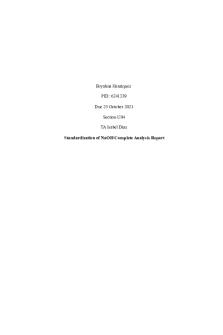CHEM standardization PDF

| Title | CHEM standardization |
|---|---|
| Author | Joanna Biswas |
| Course | Principles Of Chemistry I |
| Institution | York College CUNY |
| Pages | 3 |
| File Size | 59.7 KB |
| File Type | |
| Total Downloads | 29 |
| Total Views | 143 |
Summary
CHEM_standardization...
Description
Preparation and Standardization of a Sodium Hydroxide Solution
ObjectiveTo determine the molarity of a NaOH solution by titrating it with a standard HCl solution. To determine the molarity of acetic acid in vinegar using the NaOH as a standard solution.
IntroductionAn acid and a base react in aqueous solutions to form water and salt. HCl(acid) + NaOH(base)→𝐻2𝑂 + 𝑁𝑎𝐶𝑙 (𝑠𝑎𝑙𝑡) Standardization is the process of determining the exact concentration (molarity) of a solution. Normality(N) = number of ew of solute/ volume of solution(liters) = # ew/ V
MaterialsPipette, NaOH solution, volumetric flask, carbon dioxide free distilled water, burette clamp, ring stand, beaker, weighing paper, analytical balance, KHP, Erlenmeyer flask, phenolphthalein.
ProcedurePart A 1. First I have used a pipette to place 10 to 15 drops, approximately 0.5mL, of 6N NaOH solution into a 25mL volumetric flask. Then I diluted the NaOH by adding carbon dioxide-free distilled water to the 25mL mark. I labeled this flask “standard NaOH”. 2. Then I supported a clean 10 mL burette in a vertical position with a burette clamp and a ring stand. I Rinsed the burette with a 1mL portion of the NaOH solution that I prepared in step 1. Then I drained the solution into a beaker through the tip of the burette.I rinsed again with another 0.5mL portion of NaOH. I used a pipet to fill the burette to the zero mark with NaOH.
Part B
1. I weigh a piece of weighing paper on the analytical balance.I recorded the weight to 0.0001g. 2. Then I placed about 0.0700 to 0.0800g of KHP on the paper and weigh. 3. Then I carefully transfer the weighed KHP crystals into a 25mL Erlenmeyer flask. 4. I repeated steps 1 to 3 for trials 2 and 3. 5. I added about 10 mL of carbon dioxide free distilled water to the flask and add 2-3 drops of phenolphthalein. 6. I read the volume of the NaOH in the buret. 7. I slowly titrated KHP acid solution with the NaOH from burette until one drop of the base turns the solution in the flask permanently pink. 8. I repeated steps 5 to 7 for the flasks marked trial 2 and trial 3. 9. Finally, I calculated the normality of the NaOH solution and calculated the average normality of the NaOH solution.
Data and results1. Weight of paper + KHP 1.0053g 1.0172g 2. Weight of paper 0.9341g 0.9377g 3. Weight of KHP 0.0712g 0.0795g 4. Number of EW of KHP 3.4868 3.8932 5. Final buret reading 1.74mL 3.26mL 6. Initial buret reading 0.19mL 1.74mL 7a. Volume of NaOH used 1.55mL 1.52mL 7b. Volume of NaOH used 0.0016L 0.0015L 8. Normality of NaOH solution 0.2179N 0.2595N 9. Average normality of NaOH solution
0.9989g 0.9743g 0.0246g 1.2047 4.87mL 3.26mL 1.61mL 0.0016L 0.0753N 0.1842N
Discussion and calculationsThis experiment is divided into two parts (Part A and Part B). In the first part of experiment, the standardize solution of sodium hydroxide is prepared by titrating it with base KHP. The indicator phenolphthalein is used to determine that whether titration is complete or not. We had to slow down when color change and using droppers is a waste of time.
Experimental errorThe analytical balance can give wrong reading due to inaccurate
measurements. Few drops of liquid remain in burette and volumetric pipette which causes the error.Adding the NaOH solution vigorously into the flask.
ConclusionBy this experiment, I am able to calculate the average normality of the NaOH solution and the molarity....
Similar Free PDFs

CHEM standardization
- 3 Pages

Chem 4 Standardization
- 5 Pages

Standardization of HCl
- 8 Pages

Standardization of hydrochloric acid
- 12 Pages

Standardization-of-Na OH
- 2 Pages

CHEM Experiment 10 - chem
- 4 Pages

CHEM-welcome - CHEM-welcome
- 2 Pages

Chem final exam chem 103
- 2 Pages

Chem Activity 3 Organic Chem
- 2 Pages

Chem Review
- 4 Pages
Popular Institutions
- Tinajero National High School - Annex
- Politeknik Caltex Riau
- Yokohama City University
- SGT University
- University of Al-Qadisiyah
- Divine Word College of Vigan
- Techniek College Rotterdam
- Universidade de Santiago
- Universiti Teknologi MARA Cawangan Johor Kampus Pasir Gudang
- Poltekkes Kemenkes Yogyakarta
- Baguio City National High School
- Colegio san marcos
- preparatoria uno
- Centro de Bachillerato Tecnológico Industrial y de Servicios No. 107
- Dalian Maritime University
- Quang Trung Secondary School
- Colegio Tecnológico en Informática
- Corporación Regional de Educación Superior
- Grupo CEDVA
- Dar Al Uloom University
- Centro de Estudios Preuniversitarios de la Universidad Nacional de Ingeniería
- 上智大学
- Aakash International School, Nuna Majara
- San Felipe Neri Catholic School
- Kang Chiao International School - New Taipei City
- Misamis Occidental National High School
- Institución Educativa Escuela Normal Juan Ladrilleros
- Kolehiyo ng Pantukan
- Batanes State College
- Instituto Continental
- Sekolah Menengah Kejuruan Kesehatan Kaltara (Tarakan)
- Colegio de La Inmaculada Concepcion - Cebu





